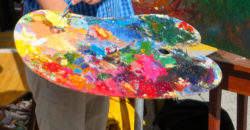 “An Eskimo custom offers an angry person release by walking the emotion out of his or her system in a straight line across the landscape, the point at which the anger is conquered is marked with a stick, bearing witness to the strength or length of the rage.” – Lucy Lippard, Overlay
“An Eskimo custom offers an angry person release by walking the emotion out of his or her system in a straight line across the landscape, the point at which the anger is conquered is marked with a stick, bearing witness to the strength or length of the rage.” – Lucy Lippard, Overlay
I really love that idea. Walking in a straight line to measure our rage. How far would yours get you? St. Louis? Cheyenne? Taipei?
And if you walked in a straight line to measure your love?
Your willingness to not know? How far would that get you?
Sure beats mapping my progress across the continental U.S. on a treadmill at 3.7 miles per hour–let me walk in representation, instead.
It’s always desperately irritating to me—in that “eat a Rice Krispie Treat in sheer frustration kind of way”—when someone writes a book I should have written. That’s how I felt several years ago when I saw Rebecca Solnit’s Wanderlust: A History of Walking. When I realized she had also written something beautifully entitled A Field Guide to Getting Lost, I upped the ante to Junior Mints, Skittles, and Blenheim’s Ginger Ale Red Label (the hottest).
Just as I am enamored of the idea of desire lines, I am buoyed by chapter titles like “The Mind at Three Miles an Hour.” Perambulating through space—how and when and for what—has long fascinated me. Sadly, we are even walking faster these days, at a time when slowing down might help. If a poem is a walk, we are woefully lacking in iambic pentameter, I’m thinking.
Wittgenstein was a pacer when he thought and wrote; I feel fairly certain that Malcolm Lowry must have been too, and certainly Virginia Woolf when she took Mrs Dalloway on that long walk through London.
Pilgrimages involve walking, creating straight lines toward faith, toward Adam’s Peak, or Mecca, looking for something larger than ourselves: it is a liminal state, a threshold between one’s past and future identities. Solnit reminds us: “When pilgrims begin to walk several things usually begin to happen to their perceptions of the world which continue over the course of the journey: they develop a changing sense of a time, a heightening of the senses, and a new awareness of their bodies and the landscape.”
Is there a personal geography? What is my pilgrimage in service to? I must walk more. I will mark my progress with a stick, to bear witness to the strength and length of my rage, or my love. “In the experience of walking,” as Solnit reports, “each step is a thought. You can’t escape yourself.” No matter how far you walk, no matter what you are carrying with you—or pushing in front of you.
 “An Eskimo custom offers an angry person release by walking the emotion out of his or her system in a straight line across the landscape, the point at which the anger is conquered is marked with a stick, bearing witness to the strength or length of the rage.” – Lucy Lippard, Overlay
“An Eskimo custom offers an angry person release by walking the emotion out of his or her system in a straight line across the landscape, the point at which the anger is conquered is marked with a stick, bearing witness to the strength or length of the rage.” – Lucy Lippard, Overlay






